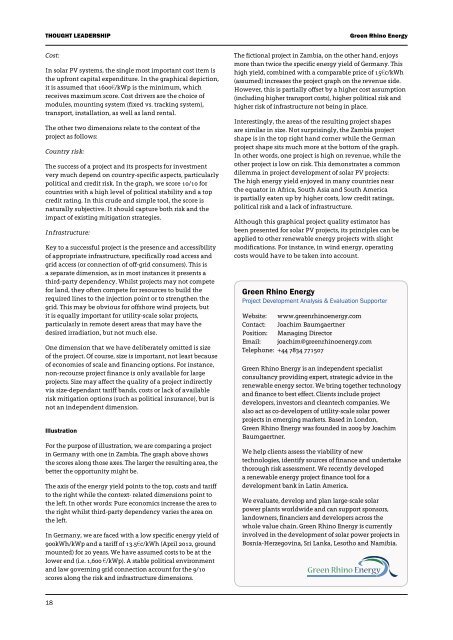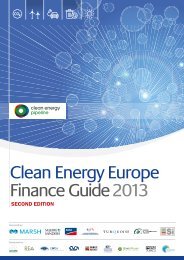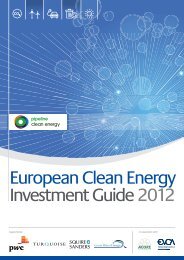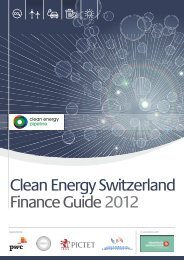European Clean Energy Investment Guide 2012
European Clean Energy Investment Guide 2012
European Clean Energy Investment Guide 2012
Create successful ePaper yourself
Turn your PDF publications into a flip-book with our unique Google optimized e-Paper software.
ThoughT leadership green rhino energy<br />
Cost:<br />
In solar PV systems, the single most important cost item is<br />
the upfront capital expenditure. In the graphical depiction,<br />
it is assumed that 1600€/kWp is the minimum, which<br />
receives maximum score. Cost drivers are the choice of<br />
modules, mounting system (fixed vs. tracking system),<br />
transport, installation, as well as land rental.<br />
The other two dimensions relate to the context of the<br />
project as follows:<br />
Country risk:<br />
The success of a project and its prospects for investment<br />
very much depend on country-specific aspects, particularly<br />
political and credit risk. In the graph, we score 10/10 for<br />
countries with a high level of political stability and a top<br />
credit rating. In this crude and simple tool, the score is<br />
naturally subjective. It should capture both risk and the<br />
impact of existing mitigation strategies.<br />
Infrastructure:<br />
Key to a successful project is the presence and accessibility<br />
of appropriate infrastructure, specifically road access and<br />
grid access (or connection of off-grid consumers). This is<br />
a separate dimension, as in most instances it presents a<br />
third-party dependency. Whilst projects may not compete<br />
for land, they often compete for resources to build the<br />
required lines to the injection point or to strengthen the<br />
grid. This may be obvious for offshore wind projects, but<br />
it is equally important for utility-scale solar projects,<br />
particularly in remote desert areas that may have the<br />
desired irradiation, but not much else.<br />
One dimension that we have deliberately omitted is size<br />
of the project. Of course, size is important, not least because<br />
of economies of scale and financing options. For instance,<br />
non-recourse project finance is only available for large<br />
projects. Size may affect the quality of a project indirectly<br />
via size-dependant tariff bands, costs or lack of available<br />
risk mitigation options (such as political insurance), but is<br />
not an independent dimension.<br />
Illustration<br />
For the purpose of illustration, we are comparing a project<br />
in Germany with one in Zambia. The graph above shows<br />
the scores along those axes. The larger the resulting area, the<br />
better the opportunity might be.<br />
The axis of the energy yield points to the top, costs and tariff<br />
to the right while the context- related dimensions point to<br />
the left. In other words: Pure economics increase the area to<br />
the right whilst third-party dependency varies the area on<br />
the left.<br />
In Germany, we are faced with a low specific energy yield of<br />
900kWh/kWp and a tariff of 13.5€c/kWh (April <strong>2012</strong>, ground<br />
mounted) for 20 years. We have assumed costs to be at the<br />
lower end (i.e. 1,600 €/kWp). A stable political environment<br />
and law governing grid connection account for the 9/10<br />
scores along the risk and infrastructure dimensions.<br />
18<br />
The fictional project in Zambia, on the other hand, enjoys<br />
more than twice the specific energy yield of Germany. This<br />
high yield, combined with a comparable price of 15€c/kWh<br />
(assumed) increases the project graph on the revenue side.<br />
However, this is partially offset by a higher cost assumption<br />
(including higher transport costs), higher political risk and<br />
higher risk of infrastructure not being in place.<br />
Interestingly, the areas of the resulting project shapes<br />
are similar in size. Not surprisingly, the Zambia project<br />
shape is in the top right hand corner while the German<br />
project shape sits much more at the bottom of the graph.<br />
In other words, one project is high on revenue, while the<br />
other project is low on risk. This demonstrates a common<br />
dilemma in project development of solar PV projects:<br />
The high energy yield enjoyed in many countries near<br />
the equator in Africa, South Asia and South America<br />
is partially eaten up by higher costs, low credit ratings,<br />
political risk and a lack of infrastructure.<br />
Although this graphical project quality estimator has<br />
been presented for solar PV projects, its principles can be<br />
applied to other renewable energy projects with slight<br />
modifications. For instance, in wind energy, operating<br />
costs would have to be taken into account.<br />
Green Rhino <strong>Energy</strong><br />
Project Development Analysis & Evaluation Supporter<br />
Website:<br />
Contact:<br />
Position:<br />
Email:<br />
Telephone:<br />
www.greenrhinoenergy.com<br />
Joachim Baumgaertner<br />
Managing Director<br />
joachim@greenrhinoenergy.com<br />
+44 7834 771507<br />
Green Rhino <strong>Energy</strong> is an independent specialist<br />
consultancy providing expert, strategic advice in the<br />
renewable energy sector. We bring together technology<br />
and finance to best effect. Clients include project<br />
developers, investors and cleantech companies. We<br />
also act as co-developers of utility-scale solar power<br />
projects in emerging markets. Based in London,<br />
Green Rhino <strong>Energy</strong> was founded in 2009 by Joachim<br />
Baumgaertner.<br />
We help clients assess the viability of new<br />
technologies, identify sources of finance and undertake<br />
thorough risk assessment. We recently developed<br />
a renewable energy project finance tool for a<br />
development bank in Latin America.<br />
We evaluate, develop and plan large-scale solar<br />
power plants worldwide and can support sponsors,<br />
landowners, financiers and developers across the<br />
whole value chain. Green Rhino <strong>Energy</strong> is currently<br />
involved in the development of solar power projects in<br />
Bosnia-Herzegovina, Sri Lanka, Lesotho and Namibia.<br />
Green Rhino <strong>Energy</strong>





